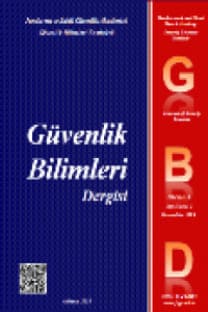İNSAN VÜCUDUNUN TERÖRİSTİN SİLAHINA DÖNÜŞMESİ: İNTİHAR TERÖRİZMİ FENOMENİ
İntihar Terörizmi, Motivasyonu, İntihar Bombacısının Temini ve Yetiştirilmesi, Demografik Yapısı
THE HUMAN BODY BECOMING THE TERRORIST'S WEAPON: THE PHENOMENON OF SUICIDE TERRORISM
Suicide Terrorism, Motivation, Recruiting and Assigning Suicide Terrorist, Demographic Characteristics,
___
- Abadie, A. (2004). Poverty, Political Freedom, and the Roots of Terrorism. John F. Kennedy School of Government, 96(2), 50-56.
- Afflerbach, H., & Strachan, H. (2012). How Fighting Ends: A History Of Surrender. Oxford: Oxford University Press on Demand.
- Berge, W. V. D. (2014). History’s Most Consequential Terrorist Attack. Terrorism and Political Violence Retrieved from https://leidensecurityandglo balaffairs.nl/articles/historys-most-consequential-terrorist-attack
- Bloom, M. (2005). Dying to Kill: The Allure of Suicide Terror. New York: Columbia University Press.
- Bryant, C. D. (2003). Handbook of Death and Dying. London: Sage.
- Burgess, M. (2003). A Brief History of Terrorism. Center for Defense Information. Retrieved from https://www.pogo.org/investigation/2015/02/brief-history-of-terrorism/
- Canter, D. V. (2010). The Faces of Terrorism: Multidisciplinary Perspectives. United Kingdom John Wiley & Sons.
- Chandran, D. S. (2003). Suicide Terrorism in South Asia: From Promised Land to Presumed Land. Institute of Peace and Conflict Studies. Retrieved from http://www.ipcs.org/focusthemsel.php?articleNo=1085
- Combs, C. C. (2002). Terrorism in the 21st Century. Boston: Routledge.
- Corbin, C. M. (2017). Terrorists Are Always Muslim But Never White: At the Intersection of Critical Race Theory and Propaganda Fordham Law Review, 86(2), 455-485.
- Demircan, D., & Aksüt, F. (2019). 48 Terrorists Surrendered to Turkish Forces This Year. Anadolu Agency. Retrieved from https://www.aa.com.tr/en/turkey/4-pkk-terrorists-surrender-to-turkish-forces/1651481
- Gerwehr, S., & Daly, S. A. (2006). Al-Qaida: Terrorist Selection and Recruitment. The RAND Corporation.
- Graitl, L. (2017). Terror as Sacrificial Ritual? A Discussion of (Neo-)Durkheimian Approaches to Suicide Bombing. Cambridge University Press, 116-131.
- Haberfeld, M., & Hassell, A. (2009). A New Understanding of Terrorism: Case Studies, Trajectories and Lessons Learned. New York: Springer.
- Hafez, M. M. (2006). Suicide Terrorism in Iraq: A Preliminary Assessment of the Quantitative Data and Documentary Evidence. Studies in Conflict & Terrorism, 29(6), 591-619.
- Jacques, K., & Taylor, P. J. (2008). Male and Female Suicide Bombers: Different Sexes, Different Reasons? . Routledge, 31(4), 304-326.
- Kaplan, J. (2016). Waves of Political Terrorism. In Oxford Research Encyclopedia of Politics. New York.
- Krueger, A. B. (2007). What Makes a Terrorist. New Jersey: Princeton University Press.
- Kushner, H. W. (2003). Encyclopedia of Terrorism. United States of America: Sage Publications, International Educational and Professional Publisher.
- Lankford, A. (2014). The Myth of Martyrdom: What Really Drives Suicide Bombers, Rampage Shooter, And Other Self-destructive Killers. Cambridge University Press, 37(4), 351-362.
- Lester, D., & Gunn, J. F. (2014). Suicide in Men: How Men Differ from Women in Expressing Their Distress. Springfield: Charles C Thomas, Publisher, Limited.
- Madsen, J. (2004). Suicide Terrorism: Rationalizing the Irrational. Strategic Insights, 3(8).
- Marthoz, J.-P. (2017). Terrorism and The Media: A Handbook for Journalists. France: United Nations Educational, Scientific and Cultural Organization
- Merari, A. (2010). Driven to Death: Psychological and Social Aspects of Suicide Terrorism. Oxford: Oxford University Press.
- Merari, A., Webber, D., Klein, K., Kruglanski, A., & Brizi, A. (2017). Divergent Paths to Martyrdom and Significance Among Suicide Attackers. Terrorism and Political Violence, 29(5), 852-874.
- Moghadam, A. (2006). Suicide Terrorism, Occupation, and the Globalization of Martyrdom: A Critique of Dying to Win. Studies in Conflict & Terrorism, 29(8), 707-729.
- Obaid-Chinoy, S. (2009). Children of Taliban From the PBS Documentary. Retrieved from https://www.pbs.org/video/frontlineworld-children-of-the-taliban/
- Pape, R. A. (2005). Dying to Win: The Strategic Logic of Suicide Terrorism. New York: Random House.
- Parker, T., & Sitter, N. (2016). The Four Horsemen of Terrorism: It's Not waves, It's Strains. Terrorism and Political Violence, 28(2), 197-216.
- Pedahzur, A. (2006). Root Causes of Suicide Terrorism: The Globalization of Martyrdom. London: Routledge.
- Post, J. M. (1990). Terrorist Psycho-Logic: Terrorist Behavior As a Product of Psychological Forces. Cambridge University Press, 25-40.
- Rae, J. A. (2012). Will It Ever Be Possible To Profile The Terrorist. Journal of Terrorism Research, 3(2). Retrieved from https://cvir.st-andrews.ac.uk/ articles/10.15664/jtr.380/
- Reuter, C. (2004). My Life is a Weapon: A Modern History of Suicide Bombing. United States of America: Princeton University Press.
- Riaz, H. (2011). Suicide Bombings. New York: Routledge.
- Schweitzer, Y. (2000). Suicide Terrorism: Development and Characteristics. International Institute for Counter-Terrorism: Online Article Series. Retrieved from https://www.ict.org.il/Article.aspx?ID=779#gsc.tab=0
- Shay, S. (2017). The Shahids: Islam and Suicide Attacks. New Jersey: Transaction Publishers.
- Smith, M., & Zeigler, S. M. (2017). Terrorism Before and After 9/11–A More Dangerous World? RAND Corporation Research and Politics, 4(4), 1-8.
- Stack, S. (2004). Emile Durkheim and Altruistic Suicide. Archives of Suicide Research, 8(1), 9-22.
- Stern, J. (2003). Why Religious Militants Kill: Terror in the Name of God. New York: Harper Collins Publishers.
- Victor, B. (2003). Army of Roses: Inside The World of Palestinian Women Suicide Bombers. Emmaus, PA: Rodale Books.
- Volkan, V. (2005). Suicide Bombers. The University of Virginia.
- Volkan, V. (2010). İntihar Bombacıları. Akademik Orta Doğu, 4(2), 1-8.
- Volkan, V. (2013). Large Group Psychology in Its Own Right: Large-Group Identity and Peace-making. International Journal of Applied Psychoanalytic Studies, 10(3), 210-246.
- Ward, V. (2018). What Do We Know About Suicide Bombing?: Review and Analysis. Politics and the life sciences, 37(1), 88-112.
- ISSN: 2147-2912
- Yayın Aralığı: 2
- Başlangıç: 2012
- Yayıncı: JANDARMA VE SAHİL GÜVENLİK AKADEMİSİ
NANOTEKNOLOJİ, TOPLUM VE MİLLİ GÜVENLİK
KİŞİLİK ÖZELLİKLERİ VE RİSKLİ SÜRÜCÜLÜK: BİR DERLEME ÇALIŞMASI
NATO’NUN DENİZ GÜVENLİĞİ ALGISI: SÜREKLİLİK VE DEĞİŞİM
AFET KURBANLARININ KİMLİKLENDİRİLMESİNDE KULLANILAN YÖNTEMLER VE ÜLKEMİZDEKİ DURUM
Niyazi Umut AKINCIOĞLU, İlker ASLAN, Yeşim DOĞAN
ASİMETRİK STRATEJİLERİN DÖNÜŞÜMÜNDE MEDYA KULLANIMI: ORTAK MANTIK, FARKLI YÖNTEMLER
SİBER GÜVENLİK KAPSAMINDA ENERJİ SİSTEMLERİ GÜVENLİĞİNİN DEĞERLENDİRİLMESİ
Hakan AYDIN, Mehmet Ali BARIŞKAN, Ali ÇETİNKAYA
SURİYE VE LİBYA’DA MEYDANA GELEN ÇATIŞMALARIN VEKÂLET SAVAŞI TEORİSİ KAPSAMINDA KARŞILAŞTIRILMASI
